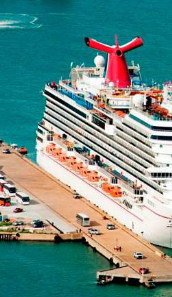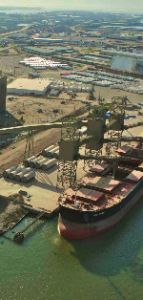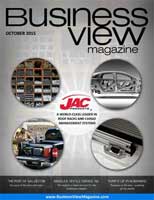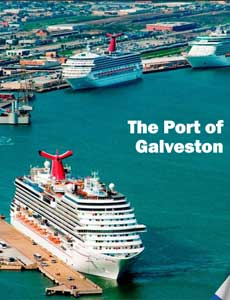Star port of the lone star state
The Port of Galveston, located on the upper Texas coast on the eastern end of Galveston Island, has a long and storied history. The area was discovered by the Spanish explorer, Juan de Grijalva in 1519, and the island became the base of operations for the French-American pirate and privateer, Jean Lafitte, in the early 19th century. In 1825, the Congress of Mexico designated Galveston a provisional port and customs entry point – an act which was repeated by the Congress of the United States in 1837, even though the government of Mexico refused to recognize Texas as an independent territory. In 1854, six years after the Mexican War ended in a decisive American victory, the State of Texas joined various dock and warehousing interests together to form the Galveston Wharf and Cotton Press Company.
 By 1900, Galveston was the leading U.S. port for the export of cotton, and the third most important for the export of wheat. In September of that same year, the Great Galveston Hurricane, with winds of 145 miles per hour, made landfall, resulting in the deaths of thousands of people and the devastation of the City of Galveston and most of Galveston Island. It was the deadliest natural disaster ever to strike the United States. Although the Port’s facilities were rebuilt, its status as the busiest port on the Gulf of Mexico was soon overtaken by the Port of Houston, which was further inland and had a greater ability to expand without restriction due to geographic features.
By 1900, Galveston was the leading U.S. port for the export of cotton, and the third most important for the export of wheat. In September of that same year, the Great Galveston Hurricane, with winds of 145 miles per hour, made landfall, resulting in the deaths of thousands of people and the devastation of the City of Galveston and most of Galveston Island. It was the deadliest natural disaster ever to strike the United States. Although the Port’s facilities were rebuilt, its status as the busiest port on the Gulf of Mexico was soon overtaken by the Port of Houston, which was further inland and had a greater ability to expand without restriction due to geographic features.
In 1940, by a vote of the citizens of Galveston, the private interests controlling the Galveston Wharf Company sold their holdings to the city of Galveston and the Port became known as the Galveston Wharves. Today, the Port of Galveston is Texas’ gateway for cruise sailings and international trade. Its facilities cover 850 acres, with 300 acres on the southern, City of Galveston side of the channel and another 550 acres on Pelican Island, 285 of which are undeveloped. The Port has 39 piers and 113 businesses that operate out of it. It is home to five major shipping lines: American Roll-on Roll-off Carrier, Del Monte, Höegh Autoliners, “K” Line America, Inc., and Wallenius Wilhelmsen Logistics; and three cruise lines: Carnival, Royal Caribbean and Disney Cruise Lines.
The Port handles export grain, dry and liquid bulk products including fertilizer, wind turbine components, high & heavy cargoes, project cargoes, vehicles and other roll-on/roll-off cargoes, household goods, refrigerated fruit and produce, liner board, military cargo, and livestock. In addition, the Port hosts a robust ship and rig repair business including a shipyard to service the offshore oil industry. The Port of Galveston generates annual operating revenues of approximately $32 million and provides more than $3.1 billion annually in economic impact to the State of Texas.
Mike Mierzwa is the Port of Galveston’s Port Director, responsible for the proper administration of all its functions. He describes the Port’s official, operating status as well as its current business model: “The Port of Galveston is what is considered an ‘enterprise utility’ of the City of Galveston. There is a Board of Trustees of the Galveston Wharves, comprised of seven individuals, six of whom are appointed by the City Council. One member is an ex- officio member of the Board who is either a member of the City Council or the Mayor. The oversight and management of the Port is left to the Board of Trustees. We’re a landlord port that derives its revenues from ‘dockage,’ which is what we charge ships to tie up at our docks, and something called ‘wharfage,’ which are the charges that we charge different entities for moving cargo, both import and export, across our docks. We don’t receive any taxpayer support from the city, so we have to be run like a business. I need to generate enough revenues to pay for my expenses and do capital improvements to my facilities.”
In order to generate those revenues, the Port of Galveston must offer the types of services that will help its business partners, who lease space in the Port’s facilities, to succeed. “We survive based upon our ability to attract businesses here,” says Mierzwa, who believes that the Port provides an excellent combination of attractive amenities. “One of the beauties about the Port of Galveston,” he explains, “is that it’s a smaller port that’s easy to get to. It’s an easy-on, easy-off port. It’s a user-friendly port from a shipper’s standpoint – our proximity to the Gulf of Mexico and the ability of a ship to get into the port quickly and get turned around quickly is a big selling point. And if you do have cargo to be moved by rail, we’re serviced by two Class One railroads, the Union Pacific and the BNSF, that can reach anywhere west of the Mississippi River and up into Canada.
“We are also serviced by a short line railroad, connected to the two Class One railroads. The two Class One’s will bring cargo down to the port, or will take cargo away from the port via their network, and the short line railroad, the Galveston Railroad, owned by Genesee & Wyoming, will go and get those cars and bring them out to port tracks that we own but lease to the Galveston Railroad.” Mierzwa adds that a portion of the Port’s income is based upon the movement of these railroad cars.
Being close to the Gulf of Mexico is also a reason that three major cruise lines have chosen the Port of Galveston as their home base (as opposed to docking in Houston, some 50 miles away), making Galveston the 4th busiest cruise port in the U.S. with respect to embarkations. “The Port of Galveston’s niche is those cargoes that are operating on a schedule. Some examples are the cruise ships,” says Mierzwa. “They have to get into port, disembark 3500 to 4600 passengers starting around 7:00 AM, and load up again and be out of the port by 4:30 or 5:00 PM at the latest. So they have a nine to ten hour turnaround. The beauty about the Port of Galveston is that it’s only about 45 minutes from the Gulf of Mexico to the Port’s docks. A ship leaving from Houston will need an extra 2-2½ hours.”
Those cruise ships and their passengers are another important component of the Port’s business. “We make money through our agreements with the cruise lines based upon the number of passengers on and off these cruise ships, or as we like to say, ‘It’s cargo that talks to you.’ Another considerable part of the revenue related to the cruise industry is that we provide parking for the cruise ship passengers. We have a very heavy ‘drive-up’ market. Most of our passengers drive to Galveston to go on a cruise, so we charge people to park their cars for either the full four, five, or seven days of the cruise they go on. That is approximately 18 percent of our revenues.”
Other customers, such as those with perishable cargo, like Del  Monte, whose ships pick up fresh fruit such as bananas, melons, and pineapples from Guatemala, or those with what is known as ro-ro (roll-on, roll-off) cargo, which is cargo that’s on wheels, such as construction equipment, farm equipment, and new automobiles, also benefit from Galveston’s closeness to the Gulf of Mexico. “The ships that carry ro-ro cargo are on a milk run,” says Mierzwa. “They will come to Galveston, offload a portion of the cargo that they have on the ship here, and may take some cargo to move, either to another port or overseas, then leave here and maybe go to Jacksonville and then Baltimore and then New York. They’ve got a schedule that they like to keep to. So, again, our proximity to the Gulf helps. The ships come in, they get to the dock right away, meaning they can start offloading or on-loading the cargo, get done what they need to get done, and they’re on their way. So they have very short turnarounds. That makes us a stronger port for that type of activity than maybe our big brother up the channel from here.”
Monte, whose ships pick up fresh fruit such as bananas, melons, and pineapples from Guatemala, or those with what is known as ro-ro (roll-on, roll-off) cargo, which is cargo that’s on wheels, such as construction equipment, farm equipment, and new automobiles, also benefit from Galveston’s closeness to the Gulf of Mexico. “The ships that carry ro-ro cargo are on a milk run,” says Mierzwa. “They will come to Galveston, offload a portion of the cargo that they have on the ship here, and may take some cargo to move, either to another port or overseas, then leave here and maybe go to Jacksonville and then Baltimore and then New York. They’ve got a schedule that they like to keep to. So, again, our proximity to the Gulf helps. The ships come in, they get to the dock right away, meaning they can start offloading or on-loading the cargo, get done what they need to get done, and they’re on their way. So they have very short turnarounds. That makes us a stronger port for that type of activity than maybe our big brother up the channel from here.”
Mierzwa says that while the Port is always looking for new clients, a key factor in its business model is maintaining a productive relationship with its current customers. “We work very hard with them to make sure that their operations are run efficiently and effectively and that they’ve got everything that they need to run their business.” Some examples he points to include partnering with Wallenius Wilhelmsen Logistics, one of the world’s largest shippers, on a deal that will allow the company to move 32,000 new BMW vehicles a year, starting in 2016. “Between the two of us, we’re putting in about $11 million in a public/private partnership to develop 18.9 acres down at the east end of the Port, where we’re going to be able to get all these new vehicles in here, starting next year,” he says.
Mierzwa also recounts how the Port recently helped another one of its major clients: “We worked with our partners at Del Monte, who has a long-term lease here. They put $12 million into a warehouse that they lease from the Port of Galveston. They put in more efficient refrigeration equipment; additional storage racks so they could handle greater volumes of product coming through their facility; and they enclosed their truck docks where they load their bananas onto the trucks. They came to us and said we needed to make some investment on their docks because the wharf apron, the width of the dock in front of their facility where the ship is tied up, is only 45 feet wide. They wanted to bring in a large, shore-based crane to bring their fruit in containers and they wanted to be more efficient on how many containers per hour they could get off their ship, because for them it’s all about getting the ship into port, and getting it turned around in 28 hours or less, so they can get back down to Guatemala, get the next load, and get back up here again all within a week. The problem was with the weight limitations and the width of that particular wharf; they couldn’t do what they wanted to do.”
So the Port of Galveston took part of a $10 million disaster recovery grant it received from the Economic Development Administration of the U.S. Department of Commerce, to be used for economic development projects, and went to work. “We took approximately seven million of that ten million dollars and expanded the wharf an additional 40 feet, so now it’s 85 feet wide. What that effectively did for Del Monte, since we made those improvements in 2012, was to increase the amount of cargo moving through that facility by 50 percent – and it increased the revenue to the Port by 28 percent. These are the types of things that we do. We really try to work with our current customers to see what we can do, working together to help them grow their business.”
Finally, Mierzwa relates how the Port worked with the Wind Turbine Division of General Electric to effectuate a $1.5 million railroad project which allowed the company to move its oversized wind towers through the Port of Galveston. The problem was that the wind towers were so big, they couldn’t safely travel on tracks that were too close together. The Port partnered with the Burlington Northern and Galveston Railroads to come up with a solution. “It paid for itself within a year,” Mierzwa notes. “Now the Port has a state-of-the-art rail system for moving wind towers.”
Clearly, Mierzwa and the Port’s 88 employees have been successful in servicing their clients in an exemplary manner. So much so that this past August, the Port of Galveston was awarded a Logistics Management 2015 Quest of Quality Award, regarded in the transportation and logistics industry as the most important measure of customer satisfaction and performance excellence. The Port was evaluated on five critical areas that include Ease of Doing Business, Value, Ocean Carrier Network, Intermodal Network, and Equipment Operations. In order to be a “winner,” a port had to receive at least five percent of the category vote. Only 16 other U.S. and Canadian ports received this year’s prestigious award.
In accepting, Mierzwa stated the following “These awards are the gold standard for customer satisfaction and performance excellence for carriers, ports, and logistics providers worldwide. We understand that our success comes from the efforts of our service providers from the carriers to the stevedores to the longshoremen that handle the cargo. Receiving this award shows that we are making the right decisions for our customers. We will continue to execute and excel on behalf of our customers’ needs and interests.”
After 195 years, the Port of Galveston is still the “Star Port” of the Lone Star State.
AT A GLANCE
WHO: The Port of Galveston
WHAT: A maritime port on the Gulf of Mexico
WHERE: Galveston, Texas
WEBSITE: www.portofgalveston.com
PREFERRED VENDORS

ADM Grain Company – Archer Daniels Midland (ADM) Company is one of the world’s largest agricultural processors and ingredient providers. ADM take crops and processes them to make food ingredients, animal feed ingredients, renewable fuels, and naturally-derived alternatives to industrial chemicals. Founded in 1902 and incorporated in 1923, ADM is headquartered in Chicago, Illinois, and operates processing and manufacturing facilities across the United States and worldwide. – www.adm.com




